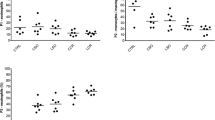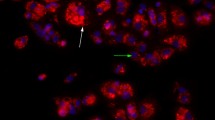Abstract
Background
Immune function is better preserved by laparoscopic versus conventional surgery. Numerous mediators of the systemic trauma response are synthesized and/or regulated by the liver. However, it has been stated that the advantages of laparoscopic surgery are no more obvious when conventional operations are performed via mini-laparotomy. We set out to compare the impact of laparoscopy and mini- and full laparotomy on the hepatic macrophage populations.
Methods
Male Lewis rats were subjected to anesthesia alone (control), mini-laparotomy (1 cm), full laparotomy (7 cm), or laparoscopy for 60 min. Endpoints were the total protein in the peritoneal lavage fluid, hepatic ED-1 cells (recruited monocytes), hepatic ED-2 cells (Kupffer cells), the expression of OX-6 in the liver, and C-reactive protein (CRP) in plasma.
Results
Protein in the peritoneal lavage fluid increased significantly after all interventions. Full laparotomy was accompanied by an enhancement in ED-1-positive monocytes in the liver parenchyma compared to all other groups (p < 0.001). Mini- and full laparotomy led to an increase in ED-2-positive Kupffer cells (p < 0.001). Laparoscopy did not affect the number of monocytes/macrophages. There was no significant alteration of OX-6 expression in either group. No change in the cellular composition in the periportal fields was observed. The CRP plasma levels did not significantly differ between groups.
Conclusions
Laparoscopy completely prevents hepatic macrophage populations from expansion and normal cell disposition is preserved. Laparotomy, irrespective of incision size, increases the number of Kupffer cells. Moreover, full laparotomy, but not mini-laparotomy or laparoscopy, causes an increase in hepatic monocyte recruitment. The regulating pathways after surgery differ from other immunologic challenges, such as sepsis, in which immunocompetent cells accumulate and are stimulated in the periportal fields.







Similar content being viewed by others
References
JD Allendorf M Bessler RL Whelan M Trokel DA Laird MB Terry MR Treat (1997) ArticleTitlePostoperative immune function varies inversely with the degree of surgical trauma in a murine model Surg Endosc 11 427–430 Occurrence Handle10.1007/s004649900383 Occurrence Handle9153168
A Ayala PJ O’Neill SA Uebele CD Herdon ICH Chaudry (1997) ArticleTitleMechanism of splenic immunosuppression during sepsis: key role of Kupffer cell mediators J Trauma 42 882–888 Occurrence Handle9191670
L Bouwens M Baekeland R Zanger ParticleDe E Wisse (1986) ArticleTitleQuantitation, tissue distribution and proliferation kinetics of Kupffer cells in normal rat liver Hepatology 6 718–722 Occurrence Handle3733004
DS Collier JA Pain DG Wight P Lovat ME Bailey (1986) ArticleTitleThe Kupffer cell in experimental extrahepatic cholestasis in the rat — a light microscopy, immunohistochemical and electron microscopy study J Pathol 150 187–194 Occurrence Handle10.1002/path.1711500307 Occurrence Handle3543274
T Decker ML Lohmann-Matthes U Karck T Peters K Decker (1989) ArticleTitleComparative study of cytotoxicity, tumor necrosis factor, and prostaglandin release after stimulation of rat Kupffer cells, murine Kupffer cells, and murine inflammatory liver macrophages J Leukoc Biol 45 139–146 Occurrence Handle2783725
JF Dhainaut N Marin A Mignon C Vinsonneau (2001) ArticleTitleHepatic response to sepsis: interaction between coagulation and inflammatory processes Crit Care Med 29 IssueIDsuppl S42–S47 Occurrence Handle10.1097/00003246-200107001-00016 Occurrence Handle11445733
M Garcia-Caballero C Vara-Thorbeck (1993) ArticleTitleThe evolution of postoperative ileus after laparoscopic cholecystectomy. A comparative study with conventional cholecystectomy and sympathetic blockade treatment Surg Endosc 7 416–419 Occurrence Handle10.1007/BF00311733 Occurrence Handle8211620
F Glaser GA Sannwald HJ Buhr C Kuntz H Mayer F Klee C Herfarth (1995) ArticleTitleGeneral stress response to conventional and laparoscopic cholecystectomy Ann Surg 221 372–380 Occurrence Handle7726672
Grande M, Tucci GF, Adorisio O, Barini A, Rulli F, Neri A, Franchi F, Farinon AM (2002) Systemic acute-phase response after laparoscopic and open cholecystectomy. Surg Endosc, DOI: 10.1007/s0046400190425, November 12
CN Gutt V Riemer C Brier R Berguer V Paolucci (1998) ArticleTitleStandardized technique of laparoscopic surgery in the rat Dig Surg 15 135–139 Occurrence Handle10.1159/000018606 Occurrence Handle9845575
K Imada Y Fukuda Y Koyama I Nakano M Yamada Y Katano T Hayakawa (1997) ArticleTitleNaive and memory T cell infiltrates in chronic hepatitis C: phenotypic changes with interferon treatment Clin Exp Immunol 109 59–66 Occurrence Handle10.1046/j.1365-2249.1997.4281327.x Occurrence Handle9218825
T Kloosterman BM Blomberg Particlevon P Borgstein MA Cuesta RJ Scheper S Meijer (1994) ArticleTitleUnimpaired immune functions after laparoscopic cholecystectomy Surgery 115 424–428 Occurrence Handle8165532
Z Kmiec (2001) ArticleTitleCooperation of liver cells in health and disease Adv Anat Embryol Cell Biol 161 1–151
PA Knolle G Gerken (2000) ArticleTitleLocal control of the immune response in the liver Immunol Rev 174 21–34 Occurrence Handle10.1034/j.1600-0528.2002.017408.x Occurrence Handle10807504
I Lauterschlager (1984) ArticleTitleCharacteristic of the strongly Ia-positive cells in rat liver Scand J Immunol 20 333–338 Occurrence Handle6390667
OH Lowry NJ Rosebough AL Farr RJ Randall (1951) ArticleTitleProtein measurement with the Folin phenol reagent J Biol Chem 193 265–275 Occurrence Handle14907713
B Luettig L Pape U Bode EB Bell SM Sparshott S Wagner J Westermann (1999) ArticleTitleNaive and memory T lymphocytes migrate in comparable numbers through normal rat liver: activated T cells accumulate in the periportal field J Immunol 163 4300–4307 Occurrence Handle10510369
AJ McMahon PJ O’Dwyer AM Cruikshank DC McMillan DS O’Reilly GD Lowe A Rumley RW Logan JN Baxter (1993) ArticleTitleComparison of metabolic responses to laparoscopic and minilaparotomy cholecystectomy Br J Surg 80 1255–1258 Occurrence Handle8242291
H Nave S Hoersten Particlevon F Helfritz S Kuhlmann J Ballof J Drube R Pabst (1998) ArticleTitleIntravenous cannulation of the freely behaving rat: frequent blood sampling and volume-dependent effect on blood leukocyte counts J Exp Anim Sci 39 67–77
NT Nguyen S Braley NW Fleming L Lambourne R Rivers BM Wolfe (2003) ArticleTitleComparison of postoperative hepatic function after laparoscopic versus open gastric bypass Am J Surg 186 40–44 Occurrence Handle10.1016/S0002-9610(03)00106-5 Occurrence Handle12842747
BH Pannen JL Robotham (1995) ArticleTitleThe acute-phase response New Horizons 3 183–197 Occurrence Handle7583160
HP Redmond RW Watson T Houghton C Condron RG Watson D Bouchier-Hayes (1994) ArticleTitleImmune function in patients undergoing open vs laparoscopic cholecystectomy Arch Surg 129 1240–1246 Occurrence Handle7986152
AB Rogers JG Fox (2004) ArticleTitleInflammation and cancer. I. Rodent models of infectious gastrointestinal and liver cancer Am J Physiol Gastrointest Liver Physiol 286 G361–G366 Occurrence Handle10.1152/ajpgi.00499.2003 Occurrence Handle14766534
AS Rosenthal (1978) ArticleTitleDeterminant selection and macrophage function in genetic control of the immune response Immunol Rev 40 136–152 Occurrence Handle89077
C Sietses ME Blomberg Particlevon QA Eijsbouts RH Beelen FJ Berends MA Cuesta (2002) ArticleTitleThe influence of CO2 versus helium insufflation or the abdominal wall lifting technique on the systemic immune response Surg Endosc 16 525–528 Occurrence Handle10.1007/s00464-001-0063-x Occurrence Handle11928041
AF Suffredini G Fantuzzi R Badolato JJ Oppenheim NP O’Grady (1999) ArticleTitleNew insights into the biology of the acute phase response J Clin Immunol 19 203–214 Occurrence Handle10.1023/A:1020563913045 Occurrence Handle10471974
H Tsutsui K Adachi E Seki K Nakanishi (2003) ArticleTitleCytokine-induced inflammatory liver injuries Curr Mol Med 3 545–559 Occurrence Handle10.2174/1566524033479618 Occurrence Handle14527086
BM Ure TA Niewold NM Bax M Ham DC Zee Particlevan der GJ Essen (2002) ArticleTitlePeritoneal, systemic, and distant organ inflammatory responses are reduced by a laparoscopic approach and carbon dioxide versus air Surg Endosc 16 836–842 Occurrence Handle10.1007/s00464-001-9093-7 Occurrence Handle11997833
FJ Vittimberga B Nolan RA Perugini L Spector MP Gallery (2000) ArticleTitleLaparoscopic surgery and Kupffer cell activation Surg Endosc 14 1171–1176 Occurrence Handle10.1007/s004640010065 Occurrence Handle11148792
RW Watson HP Redmond J McCarthy PE Burke D Bouchier-Hayes (1995) ArticleTitleExposure of the peritoneal cavity to air regulates early inflammatory responses to surgery in a murine model Br J Surg 82 1060–1065 Occurrence Handle7648154
MA West DJ Hackam J Baker JL Rodriguez J Bellingham OD Rotstein (1997) ArticleTitleMechanism of decreased in vitro murine macrophage cytokine release after exposure to dioxide: relevance to laparoscopic surgery Ann Surg 226 179–190 Occurrence Handle10.1097/00000658-199708000-00010 Occurrence Handle9296512
Acknowledgments
The excellent technical assistance of Karin Westemann is very much appreciated. This research was supported by a grant (HiLF) from the Hannover Medical School, Hannover, Germany.
Author information
Authors and Affiliations
Corresponding author
Rights and permissions
About this article
Cite this article
Jesch, N., Vieten, G., Tschernig, T. et al. Mini-laparotomy and full laparotomy, but not laparoscopy, alter hepatic macrophage populations in a rat model. Surg Endosc 19, 804–810 (2005). https://doi.org/10.1007/s00464-004-2189-0
Received:
Accepted:
Published:
Issue Date:
DOI: https://doi.org/10.1007/s00464-004-2189-0




